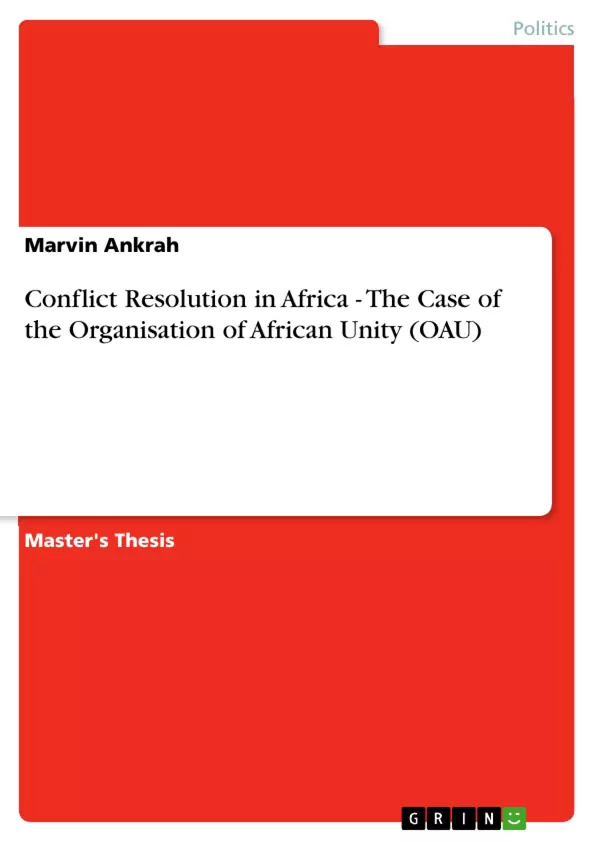The objective of this paper was to investigate the causes of conflict in Africa and the role played by the Organisation of African Unity (OAU) in ensuring political order during its period of existence. The study employed content analysis of historical documents, academic works, Internet sources and also current conflict situations in Africa as a baseline for its argument. The results showed that, despite the role of ethnicity as a source of conflicts in Africa, political and economic factors are the major sources of tension on the continent. The OAU, this paper argues, could not have a tangible impact in its attempt to ensure peace and stability on the continent, hence the functional shift in the role of Sub-regional Organisations in the continent in the area of peace and security. Notwithstanding its logistical and financial weaknesses, the Organisation failed to understand the sources of tension of most of these conflicts so as to map out a more pragmatic, multi- sectoral, and multi- dimensional approach to manage and resolve them. Factors such as the need for a more pragmatic and realistic continental policies involving good governance and genuine decentralisation were identified as crucial elements of consideration if Africa is to enjoy a sound, stable, peaceful, political and economic environment in the new millennium.
Inhaltsverzeichnis (Table of Contents)
- Chapter 1: Background
- 1.1. The Global Conflict Situation
- 1.2. The Conflict Situation in Africa
- 1.3. Conflict Transformation Model (CTM)
- Chapter 2: Causes of Conflicts in Africa
- 2.1. The Search for Sources and Answers
- 2.1.1. The Colonial Legacy and the Ethnic Factor
- 2.1.2. The Political Dimension-The Role of the Elites
- 2.1.3. The Economic Dimension
- Chapter 3: The Organisation of African Unity
- 3. 1. Introduction
- 3.2. The Charter of the OAU
- 3. 3. Objectives of the OAU
- 3. 4. Principles of the OAU
- 3. 5. Structure and Organs of the OAU
- 3.5.1. The Assembly of Heads of State Government
- 3.5.2. The Council of Ministers
- 3.5.3. The Secretariat
- 3.5.4. The Commission of Mediation, Arbitration and Conciliation: Organ for conflict resolution
- 3.6. Approaches to Conflict Resolution by OAU
- 3.6.1. Summit Diplomacy
- 3.6.2. Ad Hoc Committees
- 3.6.3. Presidential Mediation
- 3.6.4. The use of Good Offices
- 3.7. Assessment of OAU-Application of Theory
- Chapter 4: Sub-regional Organisations and Peace in Africa - The Case of ECOWAS Intervention in Liberia
- 4.1. West Africa-the Black House of Africa
- 4.2. The Liberian Civil War-Underlying Factors
- 4.2.1. The Role of the Liberian Elites
- 4.2.2. The Economic Dimension
- 4.2.3. The External Connection
- 4.3. The Role of ECOWAS
- 4.4. Analysis of success
Zielsetzung und Themenschwerpunkte (Objectives and Key Themes)
This work explores the approaches to conflict resolution in Africa, using the Organization of African Unity (OAU) as a case study. It aims to analyze the role of the OAU in resolving conflicts in Africa, examining the effectiveness of its approaches and the challenges faced by the organization.- The conflict situation in Africa and the role of the OAU in resolving conflicts.
- The causes of conflicts in Africa, including the colonial legacy, political and economic factors.
- The structures, principles, and approaches of the OAU to conflict resolution.
- The effectiveness of the OAU's conflict resolution mechanisms.
- The case of ECOWAS intervention in Liberia as a sub-regional example of peacemaking in Africa.
Zusammenfassung der Kapitel (Chapter Summaries)
Chapter 1 provides an overview of the global conflict situation and focuses on the specific challenges facing the African continent. It introduces the Conflict Transformation Model (CTM) as a theoretical framework for understanding and addressing conflict. Chapter 2 delves into the causes of conflicts in Africa, exploring factors such as the colonial legacy, the role of political elites, and economic disparities. Chapter 3 examines the structure, principles, and objectives of the OAU, highlighting its efforts towards conflict resolution through various mechanisms like summit diplomacy, ad hoc committees, and presidential mediation. Chapter 4 analyzes the case of ECOWAS intervention in Liberia, showcasing a sub-regional approach to conflict resolution in West Africa. This chapter examines the factors that contributed to the Liberian Civil War and the role of ECOWAS in restoring peace.
Schlüsselwörter (Keywords)
This paper focuses on conflict resolution, the Organization of African Unity (OAU), African conflicts, colonial legacy, political elites, economic disparities, conflict transformation, peacemaking, sub-regional organizations, and the case of ECOWAS intervention in Liberia.- Citar trabajo
- Marvin Ankrah (Autor), 2004, Conflict Resolution in Africa - The Case of the Organisation of African Unity (OAU), Múnich, GRIN Verlag, https://www.grin.com/document/201977



